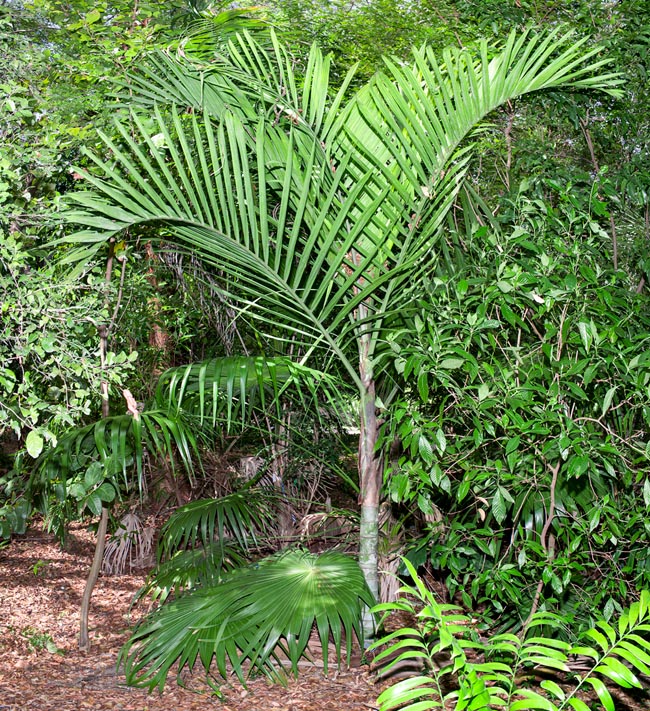Family : Arecaceae

Text © Pietro Puccio

English translation by Mario Beltramini
The species is endemic to north-eastern Caledonia where it grows in the humid forests on acidic rocky soils close to the waterstreams, up to about 500 m of altitude.
The name of the genus is the combination of the Greek adjective “κυφός” (cyphos) = humped, hunchbaked and of the genus Phoenix, with reference to the remainder of the stigma on the fruit; the specific name is the Latin adjective “elegans, -antis” = elegant, with obvious reference.
The Cyphophoenix elegans (Brongn. & Gris) H.Wendl. ex Salomon (1887) is an unarmed monoecious species with solitary stem, erect, of green colour, smooth, 8-10 m tall and of 10-18 cm of diameter, with prominent anular traces of the junction of the fallen leaves. The leaves, on a 10-25 cm long petiole, are pinnate, arcuate, up to about 2 m long, with 25-27 linear leaflets with acute apex, up to 1,1 m long and 3,5 cm broad in the central part, rigid, regularly arranged along the rachis to form a V facing upwards, of intense glossy green colour above, paler below and provided of brown ramenta (tiny elongated scales), twisted along the central rib.

Little cultivated due to its low growth, Cyphophoenix elegans of New Caledonia stands even short frosts © G. Mazza
The foliar tubular base, of olive green colour and covered by a thin greyish tomentum, wraps entirely the stem for a length of 60-90 cm. Inflorescences, on short peduncle, under the leaves (infrafoliar), erect, ramified, up to 70 cm long and 1,3 m broad, initially of reddish colour, with unisexual flowers arranged in triads (one female flower amid two male ones): the inflorescences are proterandous (the male flowers ripen before the female ones, this avoids the self-fecundation favouring the cross-fertilization).
Ovoidal fruits, about 2 cm long and of 1,5 cm of diameter, of orange red colour turning reddish brown when ripe, with the residue of the stigma at the apex, containing only one ovoidal seed about 1,7 cm long and of 0,7 cm of diameter.
It reproduces by seed in draining acidic loam maintained humid at the temperature of 26-28 °C, with germination times starting from 2 months.
Elegant in name and in fact and of contained dimensions, hence utilizable also as ornament of the small gardens of the tropical, subtropical and milder warm temperate climate zones, where it can stand temperatures up to -3 °C. It prefers acidic soils rich of organic substance, a slight initial shade and high atmospheric and in the soil humidity, but adapts also to slightly alkaline soils, to full sun and to short dry periods. The main drawback is the speed of growth especially during the first years of life, already fairly low in nature, that becomes even lower in cultivation as we move away from the ideal conditions of climate and sun. Particularly in the Mediterranean type climates the growth becomes extremely low, situation that may be only partly improved with regular and abundant waterings during the summer period and due fertilizations with balanced products with microlements under form of chelates. Therefore, it is not surprising that it is not regularly offered in the nurseries and it is present almost exclusively in botanical gardens and in lovers’ collections.
Due to the progressive reduction of its habitat, the limited number of individuals, the frequent fires and the presence of deer, rats and pigs that limit its natural regeneration, it has been inserted (2016) in the red list of the IUCN (International Union for Conservation of Nature) among the species at very high risk of extinction in the forthcoming future (“Endangered”).
Synonyms: Kentia elegans Brongn. & Gris (1864).
